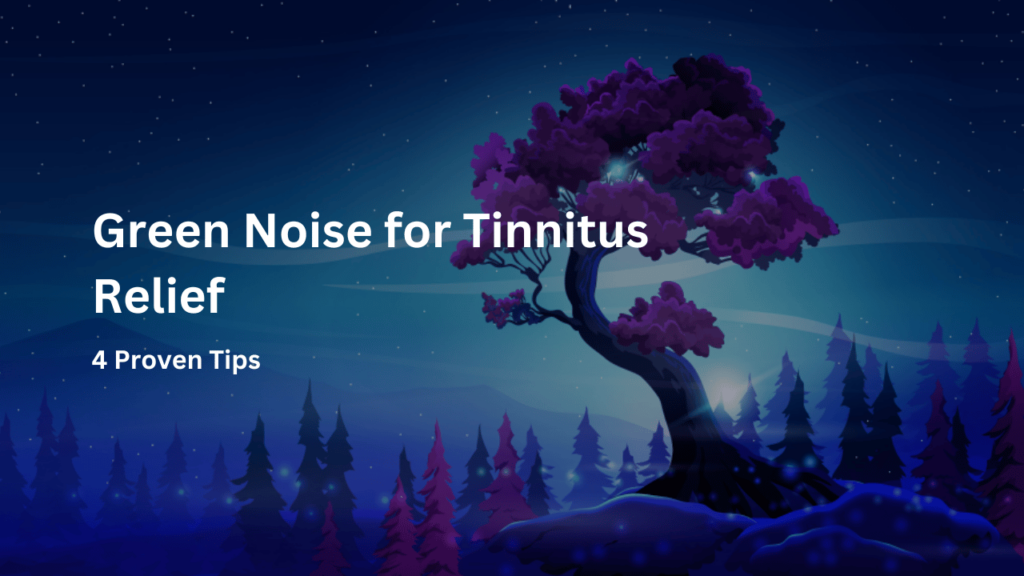Tinnitus, a condition characterised by the perception of noise or ringing in the ears in the absence of an external sound source, affects millions of individuals worldwide. It can manifest as various sounds, including ringing, buzzing, hissing, or whistling, and its impact on daily life can range from mildly annoying to severely debilitating.
Among the spectrum of sound therapies used for tinnitus management, green noise for Tinnitus recently garnered attention due to its potential benefits.

What is Green Noise?
Green noise is a type of sound that is designed to mask tinnitus at a comfortable volume level. It gets its name from having a sound spectrum similar to the color green – soothing, natural, and balanced.
Unlike white noise which contains all frequencies, green noise emphasizes mid-range frequencies that are most effective at covering tinnitus sounds.
The overall effect is a gentle, ambient sound that blends into the background seamlessly.
Some describe green noise as resembling soft rain, jungle noises, or the hum of a fan. It provides sufficient auditory stimulation to distract the brain from focusing on tinnitus noises.
But it is not so intrusive as to be disturbing or uncomfortable when listening for longer periods. Many people find green noise pleasant and relaxing to listen to even without tinnitus.
The Science Behind Green Noise and Tinnitus
Psychological Comfort
The sounds encapsulated in green noise are often associated with natural calmness and serenity. For individuals with tinnitus, the psychological comfort provided by these sounds can be a significant relief.
The natural aspect of green noise helps shift focus away from the tinnitus sounds to a more relaxing auditory experience.
Sound Masking
Similar to other forms of noise therapy, green noise can mask the internal sounds of tinnitus. By providing a constant, soothing background sound, it can make the tinnitus less noticeable, especially in quiet environments where tinnitus can be more pronounced.
Stress Reduction
Stress and anxiety are both triggers and exacerbators of tinnitus. The calming effect of green noise can help reduce stress levels, creating a positive feedback loop that potentially lessens the severity of tinnitus symptoms.
Improved Sleep Quality
Many individuals with tinnitus find it challenging to fall asleep or stay asleep due to the intrusive nature of their tinnitus sounds.
Green noise, with its soothing natural sounds, can create a more conducive environment for sleep, aiding in both the ease of falling asleep and the quality of sleep throughout the night.
Incorporating Green Noise into Tinnitus Management
Accessing Green Noise
Green noise can be accessed through various means, including specialized apps, online platforms, or sound machines designed to emit nature-based sounds. Finding the right source of green noise that resonates with you personally is crucial for its effectiveness.
Creating a Routine
Incorporating green noise into a daily routine can enhance its benefits. Listening to green noise during periods of high stress, before bedtime, or during meditation can help maximize its stress-reducing and sleep-inducing effects.
Volume Considerations
It’s essential to listen to green noise at a comfortable volume. The goal is to mask the tinnitus without overwhelming the auditory system or causing further hearing damage.
Combining with Other Therapies
Green noise can be part of a comprehensive tinnitus management plan that includes other therapies such as cognitive-behavioral therapy (CBT), mindfulness meditation, and, if applicable, hearing aids.
Consulting with a healthcare professional can help tailor a multifaceted approach that addresses both the auditory and emotional aspects of tinnitus.
Research on Green Noise for Tinnitus
While more research is still needed, initial studies on using green noise have been promising:
- A 2016 study had participants with tinnitus listen to music modified to contain green noise. Over 8 weeks, they experienced significant decreases in perceived tinnitus loudness and annoyance compared to a control group.
- An analysis of several studies concluded that green noise may promote habituation to tinnitus by activating calming neural networks in the auditory cortex and limbic system of the brain.
- Researchers suggest green noise may positively impact tinnitus by promoting neuroplastic changes in the brain’s auditory processing systems. The neural networks learn to filter out and inhibit perception of tinnitus sounds.
- Subjective surveys find the majority of users report green noise provides some relief from tinnitus distress and helps them fall asleep more easily. Though individual results can vary substantially.
- While not a cure, green noise is an accessible, non-invasive and low risk method that can provide real benefit for managing troubling tinnitus symptoms. If traditional treatments have not helped your tinnitus, discussing green noise with your audiologist may be worthwhile. The soothing, balanced soundscapes of green noise just might provide some much-needed relief.
Frequently Asked Questions (FAQs)
Q1: Does green noise help tinnitus?
Ans: Potentially yes. The mid-range frequencies of green noise can mask some tinnitus tones. It may not be as effective as white, pink or brown noise though.
Q2: What is green noise good for?
Ans: Green noise is claimed to have a calming, therapeutic effect for the brain. Some find it enhances focus, reduces stress or helps with sleep issues beyond just tinnitus relief.
Q3: Is green noise healing?
Ans: There’s no evidence showing green noise heals specific medical issues. But the relaxing qualities may aid healing and health indirectly through stress reduction.
Q4: Is green noise better than white noise?
Ans: It depends on the individual and type of tinnitus tones. Green noise works better at covering tinnitus noises centred in the 500-2000 Hz range. Preference varies.
Q5: What frequency is green noise?
Ans: Green noise emphasises mid-range frequencies spanning 500 Hz to 2,000 Hz, between white and pink noise ranges.
Q6: What color noise calms the brain?
Ans: For relaxation and sleep, pink noise and green noise tend to have a more calming effect than white or brown noise since they de-emphasise harsh high frequencies.
Conclusion
Green noise represents a promising, naturalistic approach to managing tinnitus. Its calming properties can offer psychological comfort, reduce stress, mask tinnitus sounds, and improve sleep quality.
While individual experiences with green noise may vary, its incorporation into a broader tinnitus management strategy can provide significant relief for many.
As with any tinnitus management technique, it’s advisable to consult with healthcare professionals to ensure a safe and effective approach tailored to your specific needs.
By embracing the serene sounds of nature, individuals with tinnitus can find a peaceful respite from their symptoms, enhancing their overall quality of life.



